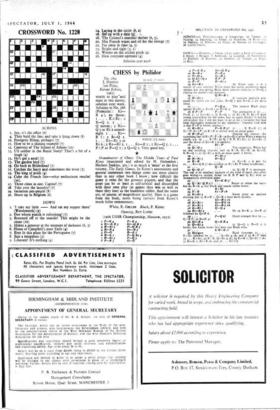CHESS by Philidor
No. 289.
BLACK .."7 WC!!
J. HARING (rst Prize, Europe Echecs, 1
wiirrE to963) play-and mate in two moves; solution next week. Solution to No. 288 (Promislo) : Kt- B 4 !, no threat.
✓ . . . KxKt; 2 B-Q 2. I . . .
Q moves ; 2 Kt- Q 5 or Kt 2 accord- ingly. I . . . Kt- B 7 ; 2 B-Q 2.
• . . . Kt-Kt 3 or Kt 6 ; 2 Kt-Kt 2. I . . Kt-B 2 ; 2 Kt--Q 5. P x P or P-Q 7; 2 Q-Q 2. Very good key.
Grandmaster of Chess: The Middle Years of Paul Keres (translated and edited by H. Golombek ; Herbert Jenkins, 3os.) is as much a 'must' as the first volume, The Early Games. In Keres's annotations and general comments two things come out more clearly than in any other book I know ; how difficult the game is even for the greatest players, and that the great can be at least as self-critical and dissatisfied with their own play (in games they win as well as those they lose) as the humblest rabbit. And the notes arc, of course, of magnificent quality. Here is a game from the book, notes being extracts from Keres's much fuller commentary.
White, E. GELLER Black, P. KERBS Opening, RUT LOPEZ
(19th USSR Championship, Moscow, 1950
P-K 4 P-K 4 a Kt-K B 3 Kt--Q B 3
3 B-Kt 5 P-QR3
4 R-R 4 Kt-B 3 s0-0 B--K2
6 R-K r P-Q Kt 4
7R-Kt.3 P-Q 3 8 P-B 3 0--0 WHITE (13 men) I..
g P-K R 3 Kt-Q R 4
to B-B 2 P-B 4 21 P-Q 4 Q-B 2 12 Q Kr-Q 2 BPxP
13 PxP B-Kt 2
14 Kt-B 1 . . . As Keres says, it is a matter of taste whether White plays this move, preserving more options but also giving Black more counter-chances, or P-Q 5 playing for queen's side pressure. 24 • • • Q R-13 z .2 B-Kt 1 . . . A variation specially pre- pared Geller for this game. B-Q 3 and R-K 2 are more usual.
P-Q 4 The Counter Black plays against B-Kt 5, B-Q 3 or R-K 2. z6 K Px P P x P The alternative is 16 ... P-K 5; 17 Kt-Kt 5, K R-Q x; 18 Kt x K P, Kt x P with strong counterplay for the pawn, but (to quote Keres) 'it will be self-evident that I did not want to go in for a variation that had been thoroughly prepared by my opponent: (General view now is that P xP is better, anyway.) 1711--/a5 P-K R 3? 57 . . . K It-K I!; 18 Kt x P. Kt x P; 19 B x B is correct with an equal game. 18 B-R 4? . . . Missing biz chance: the surprising line IS 13 x Pl, P x B; 19 Q-Q 2! gives White a winning attack, e.g. r9 . - B xr; 20 Q x It P, B x Kt; 2I Kt-Kt 3! and the threat of Kt-B 5 is decisive.
58 . . . Kt x P
19 Q-Q ,T . . . Too optimistic; White has no real attacking chances, and 19 B x B, Kt x B; 20 Kt x P, K R-Q 1; 21 Q-Kt 4 with an equal game is better.
P-Kt 3 so B-Kt 3 B-Q 3
ar B x B . .. 21 Kt-K 5 is met by 21 . . . Kt-Q B 5! the sacrifice 22 Kt x Kt P being insufficient. Q x B 22 *Q-Q 2? . . . 22 Q XI P is necessary.The text is an excellent example of the kind o move that often
goes wrong-a tactical threat (to K Ft P and Q Kt) with an incompletely developed game.
22 Kt-K B 5! 23 Qx Kt (Q RS)? . . . Better to refute the sacri- fice by B-K 4, but Black stiKllt stands rather better.
Bx 24 PxB KtxP ch
25 K-Kt a . . . Keres gives an analysis showing that 25 K-R r, Q-13 5 loses more quickly. Kt-B 5 ch 26 K-Kt I. Kt-R 6 ch
27 K-Kt a Kt-B 5 ch
28 K-10 a Q-Q 4 ag Kt-Kt 3 . . . Or 29 B-K 4, Q-R 4! followed by Q-R 6. P-Q 6! Much stronger than 29 ...
Q x P; 30 E-K 4! 30 Kt-K 4 Q-k B 4 - 3r Q-Kt 4 . . . 3! Q-Q 2, R-B 5 is better, but Keres shows that here also Black wins. 31 • • • K R-K r! 32 Resigns . . . Black threatens 32 . . . R x Kt followed by 33 • • • Q-Kt 4 chi and if 32 B xP then 32 ... R xKt; 33 R x R, Q-Kt 4 ch; 34 K-11 I, Q-Kt 7 cb; 35 K-K r, Kt x E ch. and 36 . .. Kt x Q.






























 Previous page
Previous page